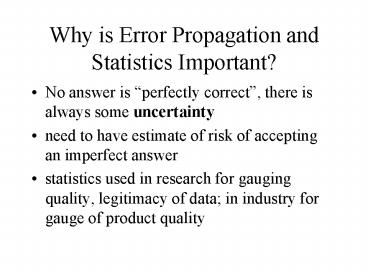Why is Error Propagation and Statistics Important - PowerPoint PPT Presentation
1 / 26
Title:
Why is Error Propagation and Statistics Important
Description:
Estimate uncertainty of measurements taken from instruments in the lab ... standard deviation of each measurement. standard deviation of the mean of the measurements ... – PowerPoint PPT presentation
Number of Views:64
Avg rating:3.0/5.0
Title: Why is Error Propagation and Statistics Important
1
Why is Error Propagation and Statistics Important?
- No answer is perfectly correct, there is always
some uncertainty - need to have estimate of risk of accepting an
imperfect answer - statistics used in research for gauging quality,
legitimacy of data in industry for gauge of
product quality
2
After This Part of the Class You Should Be Able
To
- Understand difference between systematic (or
method) error and random experimental error - Estimate uncertainty of measurements taken from
instruments in the lab - Propagate these uncertainties (or errors)
through subsequent calculations
3
After This Part of the Class You Should Be Able
To
- Compare results to accepted values (or other
literature or correlated values) and
determine whether the difference is significant
or not - State answers with proper significant
figures
4
Use repeat measurements to estimate error in a
result, calculate and understand
- mean
- standard deviation of each measurement
- standard deviation of the mean of the
measurements
- Relationship between standard deviation and
confidence intervals
5
After This Part of the Class You Should Be Able
To
- Use linear regression, understand, and interpret
simple regression statistics - r2
- confidence intervals on slope and intercept
- Interpret the meaning of confidence intervals for
more complex models
6
After This Part of the Class You Should Be Able
To
- Understand normal (Gaussian) distributions and
how they relate to probabilities, standard
deviations, confidence intervals, etc.
7
Importance of uncertainty in making conclusions
8
Estimating uncertainty from scales
- Can often interpolate to the nearest 0.2 unit on
scale depending on size of scale, access, etc.
9
Significant Figures
- Number of figures reported implies significance
(meaningfulness) to that level of precision
10
Significant Figures
- Rule for Stating Uncertainties
- Experimental uncertainties should almost always
be rounded to one significant figure. - Rule for Stating Answers
- The last significant figure in any stated answer
should usually be of the same order of magnitude
(in the same decimal position) as the uncertainty.
11
Example from before. . .
Student reported
W/m2
(calculated)
Suppose
(reported)
Then by the first rule
And adding the second rule we would report the
full answer as
12
Discrepancy the difference between 2 measured
values of the same quantity
13
Expression of Error
- Basically, two ways of doing
- repeat measurements several times and use mean
and measure of the spread (std. dev.) to
determine best estimate and probable error range - use propagation of error?
14
Propagation of error
- The text begins by giving you provisional rules
for a given form - these are just derived using the general rule
(definition of total differential) - For complex forms, you can either apply the
general rule directly, or break equation down
into the simpler forms and combine the
provisional rules
15
Differentials to determine propagated error
Recall from calculus
Note here the differential dx is taken to be any
non-zero number (?x). This differs from the
derivative which is defined as
16
(No Transcript)
17
Recall further from calculus
This definition allows us to find propagated
error for calculations that include more than one
measured variable?
18
Returning to our example from before. . .
- Q/A is calculated as
So applying the rule for the total differential
?
19
And that reduces to. . .
Here, I have added absolute value brackets, since
we dont know if the deltas are or -, and we
want the maximum error on Q/A
So what values do we use for the deltas? ?
20
Recall that I and V were read from an analog
meter, so we will use the rules we discussed
earlier
21
Dimensions were given as D13.6 mm and L 33 mm.
We have to assume delta (error) values based on
implied precision and guess as to what was used
to measure. . . .
These would be reasonable if a ruler were used
for L and a micrometer was used for D.
22
Plugging values into our equation. . .
23
So our final answer would be stated as . . .
So our method is much less precise than our
students report would have led us to believe!
However. . .
24
Since the majority of the error was due to the
measurement of area, and since the area will be
the same for all calculations, we can just use
error on amperage and voltage when comparing one
run with another. . .
25
Propagation of error
- Using this method gives the maximum possible
error. - Next week we will discuss using assumptions that
the sign of the error is randomly positive or
negative to justify addition in quadrature to
reduce the magnitude of the statement of error
26
Homework
- Chapter 2
- 2.3, 2.4, 2.6, 2.8, 2.10, 2.13, 2.18 (Excel),
2.28 - Chapter 3
- 3.6, 3.10, 3.16, 3.30, 3.32, 3.38, 3.45

